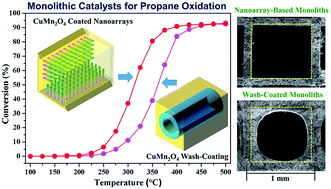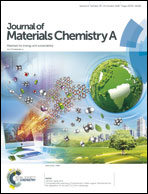Copper manganese oxide enhanced nanoarray-based monolithic catalysts for hydrocarbon oxidation†
Abstract
Copper manganese oxide (CuMn2O4) was introduced into the nanoarray-based monolithic catalysts system for advanced exhaust after-treatment. Through scalable and cost-effective hydrothermal reactions, nanosheet layers of copper manganese oxide were uniformly coated onto the manganese oxide nanoarrays (HM-PCR), which were grown on the cordierite honeycomb monoliths. The core nanoarray support, HM-PCR, a well-defined array architecture for active material deposition, contributed to an increase of open surface area and thus enhanced catalytic oxidation performance. The CuMn2O4 coated nanoarray-based catalyst, NA-CuMn2O4, shows efficient 90% propane (C3H8) conversion at around 400 °C, which is 50 °C and 75 °C lower than CuMn2O4 wash-coated catalyst (WC-CuMn2O4) and Pd loaded catalyst (WC-Pd), respectively. Compared to monolithic catalysts with a traditional alumina support, the benefit of nanoarray morphology was demonstrated by correlating the variation of surface area to the reactivity. The incorporation of cobalt ions was found to increase the specific surface area and thus enhance C3H8 conversion of CuMn2O4. The CuMn2O4/MnO2 nanoarray-based monoliths are promising types of emission control devices.

- This article is part of the themed collection: 2018 Journal of Materials Chemistry A HOT Papers


 Please wait while we load your content...
Please wait while we load your content...
